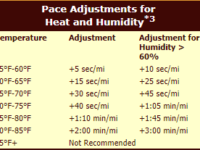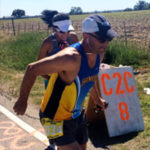It’s inevitable that running in the heat will feel harder than in cooler temperatures, but here are some ways to make the challenge a little less daunting:
1. Run by effort.
While this may seem obvious, it’s amazing how many runners still feel the need to stick to a precise pace better suited to cooler conditions. While proper pacing is important, it’s time to let go and run by feel when it’s hot. A heart-rate monitor can be a useful tool to help you gauge both easy efforts and workouts such as tempo runs, and it will also alert you to cardiac drift.
If a run is meant to be easy, throw the pace out the window and concentrate instead on your breathing and how you feel. Easy runs should feel easy, and in hot, humid conditions, this may mean that your pace decreases substantially. That’s OK. The benefits will come as your body begins to adjust, and you’ll be pleasantly surprised by your speed when cooler weather arrives.
2. Timing is everything.
When it’s hot outside, timing your run appropriately can often mean the difference between a comfortably challenging workout and a suffer fest. Early morning is the coolest time of the day (especially if you’re willing to get out in the predawn hours), though humidity levels are likely to be higher. Some runners prefer heat to humidity, and vice versa, so experiment to see what time works best for you.
While a warmup routine is always advisable, you may want to minimize this to keep your body temperature slightly cooler before a run. For a race or hard workout, you may need to run less warmup mileage than you would on a cold winter day.
Do your best to avoid the worst of the heat, but sometimes it pays to embrace it. If you’re preparing for a summer race where you know you’ll face challenging conditions, you may want to practice one run each week during the hotter part of the day to help you adapt. As always, use common sense and hydrate appropriately — you’re trying to acclimate, not run yourself into the ground.
3. Focus on nutrition and hydration.
While nutrition and hydration are always essential components of training and racing well, summer weather is less forgiving when you make a mistake. Newer research does show you don’t necessarily have to drink a predetermined quantity at prescribed intervals, pay attention to your thirst and the color of your urine. A pale lemonade color is ideal — dark urine may indicate inadequate hydration.
If you’re racing longer distances in the heat, practice your hydration and nutrition frequently. Food and drinks that are palatable in cooler weather may not settle as well in the heat, so be prepared to adjust your strategy if necessary. Drinks with electrolytes will help you maintain a proper balance of sodium and potassium relative to your water consumption.
“Precooling” is another strategy you may want to try, especially when running a marathon or ultra in the heat. While elite runners use elaborate gear such as cooling vests, try something as simple as eating a frozen Gatorade slushy before your race. This helps cool your internal body temperature and delay the inevitable rise as long as possible.
4. Stay cool on the run.
In order to stay cool on the run, start by dressing appropriately, in light colors and technical fabrics that will help wick sweat more effectively. Protect your eyes and face from the sun with a hat or visor and sunglasses. Continuous access to cold fluids is ideal, but too much hydration (especially in the absence of electrolytes) can pose its own set of problems, including hyponatremia.
Wet towels frozen the night before your run can be useful before and during a run. Dumping water on your head throughout your run can also be an effective cooling mechanism since it increases evaporation from your skin.
5. It’s all in your head.
While running in the heat has many physical ramifications, it’s important to take an appropriate mental approach as well. Adjusting your expectations at the outset will undoubtedly contribute to a more successful race or workout. Nonetheless, don’t always expect the worst. Pace yourself appropriately and you may be surprised by your performance, especially after you have given yourself adequate time to adapt to the conditions.
While studies show that it can take more than two weeks of training in heat and humidity to fully adapt, hot weather running can always be a positive training tool if incorporated with both restraint and optimism. Part of learning to race well involves coping successfully with discomfort, and running in the heat can be an invaluable learning tool.
6. Hydration and Humidity
It is important to drink, not only prior to the run, but also during the run. Keep hydrated on your non-running days too! It is good to develop a habit of drinking well and regularly well before travelling. The body will need not only water, but electrolytes too.
High 5 Zero tablets, Nuun tablets are a similar products. Neither of them contains sugar. Another great source is Elete, with a mix of inland sea water (for the salt) and potassium and calcium, providing a neutral flavored electrolyte replacement. No matter how great they are, it would be a shame not to alternate these electrolytes with the ones found in natural products. The country is covered in fruit and veg markets and there is no way of not indulging in fresh coconuts, bananas, fruit and milk shakes of your choice; the water rich watermelons and cucumbers and much more. The fruits there taste delicious and your body will be grateful for it.
Drinking cold water during the day and after the run helps the body to cool down.
If you are confused about your hydration needs, follow this easy formula. You weigh yourself naked before and after the run, and follow your liquid intake during the run. Take away the post-run weight from the pre-run weight, and add the ounces of liquid you drank. This will show you how much fluid you have lost. Dividing this figure by the number of miles you have run, will show you how much fluid you need per mile. Following this formula should help you maintaining your body's functions.
Reap the rewards!
As you continue to practice running in the heat, your body does some amazing things to adapt. You’ll become more efficient at dissipating heat and regulating your core temperature. Over time, your sweat gets less salty to maintain a proper electrolyte balance, and your body learns to sweat at lower temperatures to jump-start the cooling process.
Train your body and brain, and you’ll be headed toward new PRs in the fall.
Below is a guide for adjustment for humidity and heat.
Try slowing down on your next long run and wee what happens. See what happens and if it makes a difference in how you complete your run.








